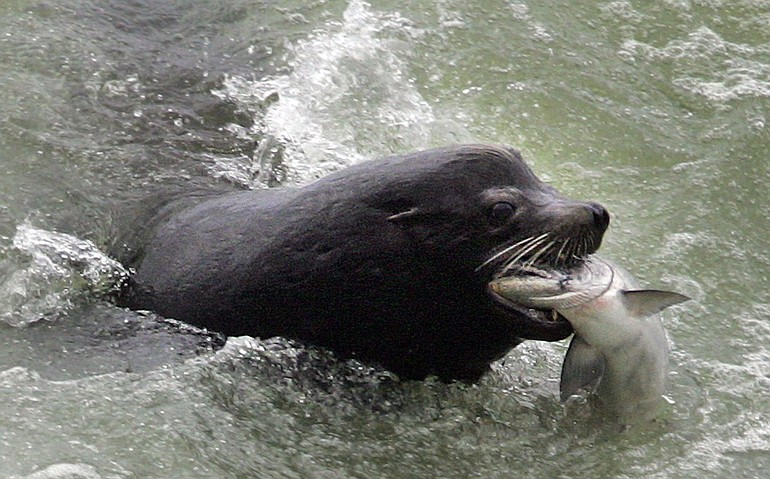A recent appeals court ruling has thrown into question the legality of a federal permit allowing state authorities to lethally remove salmon-eating sea lions congregating in front of Bonneville Dam.
Yet an advisory panel suggests another approach in a new review:
Shoot them.
A majority of the 18-member Pinniped-Fishery Interaction Task Force recommend tougher action against sea lions that started following the spring salmon migration 143 miles up the Columbia River to the dam almost a decade ago. The group encouraged Washington and Oregon game agents to shoot nuisance sea lions from boats and from land.
The task force also suggested making it easier for authorities to identify nuisance animals before dispatching them, and it recommended expanding the number of floating traps from two to three.
Dead sea lions may even be used as a macabre deterrence for others, the report suggested.
“Some members suggested the wtates should test a combination of lethal and non-lethal techniques, by exposing a euthanized individual to other (sea lions),” according to the report.
Since the program began in early 2008, state wildlife agents have captured and euthanized 22 animals and relocated 10 sea lions to zoos or aquariums willing to take them. The animals were euthanized by lethal injection.
Brian Gorman, a spokesman for the National Marine Fisheries Service in Portland, said the agency will weigh the task force’s recommendation as it also considers whether to appeal a ruling by the 9th U.S. Circuit Court of Appeals last month. Gorman expects the issue will be resolved by the time sea lions begin to arrive with the spring salmon migration in February.
A three-judge panel of the 9th Circuit last month ruled in favor of a lawsuit brought by the Humane Society of the United States.
The organization argued that state and federal fishery managers permit human fishermen an “incidental take” of between 5.5 and 17 percent of wild Columbia River salmon stocks each year without jeopardizing the species’ survival. Sea lions, by comparison, have been documented eating as much as 4.2 percent of the combined run of wild and hatchery-raised salmon arriving at the dam.
The National Marine Fisheries Service granted the states a waiver of the Marine Mammal Protection Act, allowing them to kill nuisance animals eating wild salmon, which are themselves protected by the Endangered Species Act. The permit authorizes the states to remove as many as 85 nuisance animals per year.
“The agency has not adequately explained its finding that sea lions are having a ‘significant negative impact’ on the decline or recovery of listed salmonid populations given early factual findings by NMFS that (fishermen) that cause similar or greater mortality among these populations are not having significant negative impacts,” according to the opinion authored by Judge Raymond C. Fisher.
The task force includes representatives of state, federal and tribal agencies, scientists, fishing lobbyists and animal-welfare experts.
Sharon Young, marine issues director for the Humane Society, served on the task force. She was the lone holdout on the original lethal-removal recommendation in early 2008, and she objected to the majority’s push for more aggressive actions now.
She was gratified by the appeals court ruling.
“Just because you’re in the minority doesn’t mean that you’re necessarily wrong,” she said.
Erik Robinson: 360-735-4551, or erik.robinson@columbian.com.



